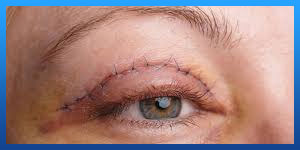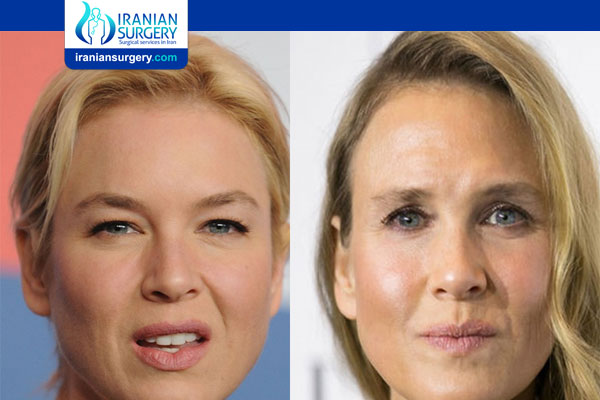When Eyelid Surgery Goes Wrong
Upper eyelid surgery gone wrong
Lower eyelid surgery gone wrong
Eyelid surgery is used to correct age-related droopy eyelids, and also for making one's eyes look younger. Most of the time, the patient comes out of surgery happy and content, but every once in a while, something goes wrong.
Possible risks of eyelid surgery include:
. Infection and bleeding
. Dry, irritated eyes
. Difficulty closing your eyes or other eyelid problems
. Noticeable scarring
. Injury to eye muscles
. Skin discoloration
. The need for a follow-up surgery
. Temporarily blurred vision or, rarely, loss of eyesight
. Risks associated with surgery in general, including reaction to anesthesia and blood clots
Read more about : How to hide blepharoplasty scars?
Read more about : Bad rhinoplasty
What are the signs that my eyelid surgery has gone wrong?
Following a blepharoplasty, patients can expect a certain amount of pain and discomfort might be experienced in the affected area for several weeks, including swelling or itchy and watery eyes.

However, when eyelid surgery goes wrong, patients may experience one of the following complications, which may be a sign that the procedure has been handled negligently:
. Removal of too much skin, leaving eyelids unable to close - known as lagophthalmos
. Lopsided appearance, or noticeable differences in the appearance of both eyes
. Removal of too little skin or tissue
. Droopiness of the lower lid - known as ectropion
. Over-correction of a drooping upper lid, resulting in damage to the cornea
. Blurred or impaired vision, in extreme cases leading to acute glaucoma
. In very rare cases, partial or complete blindness
What are the consequences?
A botched eyelid surgery can have severe consequences. Not only does it drastically alter the way you look, it can also cause dry and itchy eyes. You may also need to take lifelong precautions like wearing sunglasses at night to avoid scratching your corneas, and using eye lubricants to avoid dryness. A corrective surgery may help if done in time, but many patients end up waiting too long to use corrective surgery because their doctor would not tell them he had done something wrong in the first place.
What are the Solutions for a botched eyelid surgery?
Revision blepharoplasty
Overwhelmingly, most blepharoplasty complications arise when the surgeons do not understand the limitations of the surgery they are working with or misapply a surgery for a given set of anatomic issues. Most blepharoplasty surgeons view their job to be the removal of skin, muscle, and fat from the upper eyelid. They think: do that job well and you will be assured a good outcome, or more cynically, a good enough job. Unfortunately, many practicing eyelid surgeons are thinly trained for what they are doing.
They can perform a cosmetic upper blepharoplasty but they cannot always diagnose when there is a preexisting problem in a given eyelid that is likely to lead to an unacceptable surgical outcome. In some cases, it can be a matter of bad luck like developing an infection after surgery or colliding with a cabinet in the immediate post-operative period before the tissues have had a chance to heal from surgery. Despite our best efforts, setbacks can occur and fixing a given situation often requires advanced skills and knowledge.
The most common issue after upper eyelid surgery is dry eye with eye discomfort after surgery. Generally, this is temporary and only requires supportive measures like using artificial tears and bland ophthalmic ointment for a few weeks. This typically gets better on its own as the muscles that help close the eyelids regain their pre-operative strength. Supportive measures are very helpful here. However, the optimal management for post-operative dry eye requires the ability to examine the corneal surface using a slit lamp.
That is a piece of equipment found in the offices of oculoplastic surgeons but often not available in the offices of other types of surgical specialists. Another common issue is wound separation in the upper eyelid crease while you are healing. While this is worrisome, it is surprising how well this heals without the need for additional surgery.
Another common issue is residual fullness in the inner corner of the eyelids. In the immediate post-operative period, this can be related to swelling. However, once you are about two months or more out from surgery, the persistence of this fullness is generally consistent with unaddressed orbital fat that can protrude in the inner corners. Very often this concern is present before surgery but left undiscussed as a cosmetic concern by the patient and unaddressed surgically by the surgeon.
This can be corrected but a surgical procedure is needed to remove this fat. Due to the possible contribution of lingering swelling after surgery, waiting approximately 6 months before undertaking revisional surgery to remove this concern should it persist is recommended.
Read more about : Blepharoplasty before and after
Lower eyelid revision methods to fix botched lower eyelids
One method that has been featured recently on medically oriented talk shows, involves releasing tissues behind the lower eyelid. The appeal of this approach is that it is relatively simple and does not involve the harvesting and grafting materials to rebuild the lower eyelid. This method is useful only in the most minimally compromised of lower eyelids. Generally, these are eyelids that can be medically managed to avoid surgery altogether. More advanced methods involve the use of cadaveric skin in the lower eyelid. This approach is only slightly more complicated than the graft-free approach.
Generally, the surgeon will place supporting stitches in the outer third of the eyelid for a week. The cadaveric skin is called Alloderm. The disadvantage of this material is that it simply will not persist for more than a few months. It has a role in minimally damaged eyelids that don’t require a more permanent graft. This surgery also does not address a weakness in the projection of the cheekbone.
Orbital decompression to fix botched lower eyelids
Cosmetic orbital decompression surgery is sometimes offered as an alternative to addressing the relative lack of cheekbone projection. This involves a significant surgery that removes bone behind the eye. The theory being that by creating more room behind the eye, the eye will not project as far. This will allow the botched lower eyelid to ride higher on the surface of the eye. Indeed, this does work. The downside is that vision-threatening orbital decompression surgery is required.
Studies estimate that one out every 750 to 1,500 individuals who have orbital decompression lose vision permanently in the affected eye from bleeding associated with the surgery. There are clinical circumstances where orbital decompression is warranted. However, in this circumstance because there are highly effective surgical alternatives that do not entail the degree of risk associated with orbital decompression orbital decompression is not warranted
Source:
. https://www.mayoclinic.org/tests-procedures/blepharoplasty/about/pac-20385174


